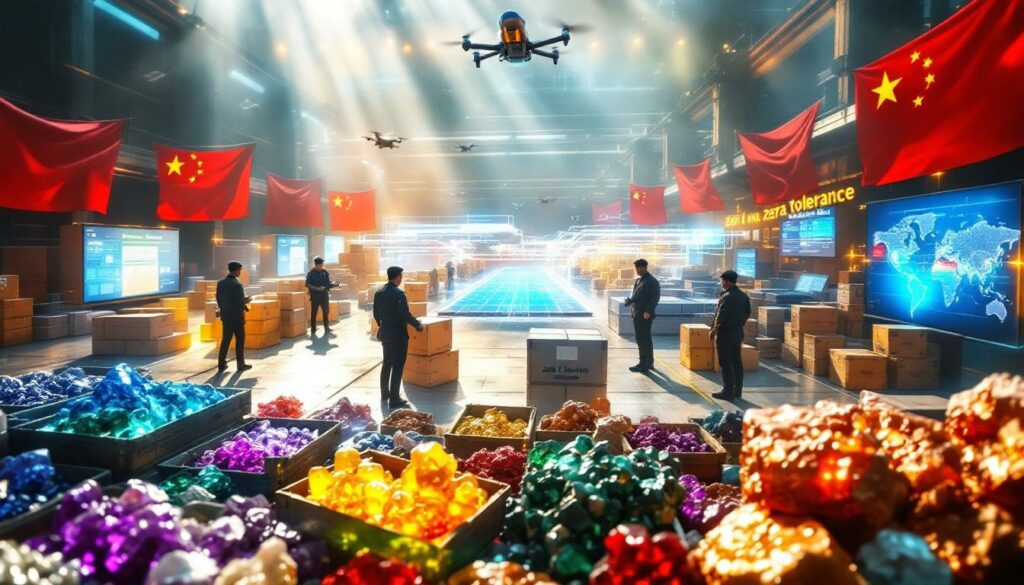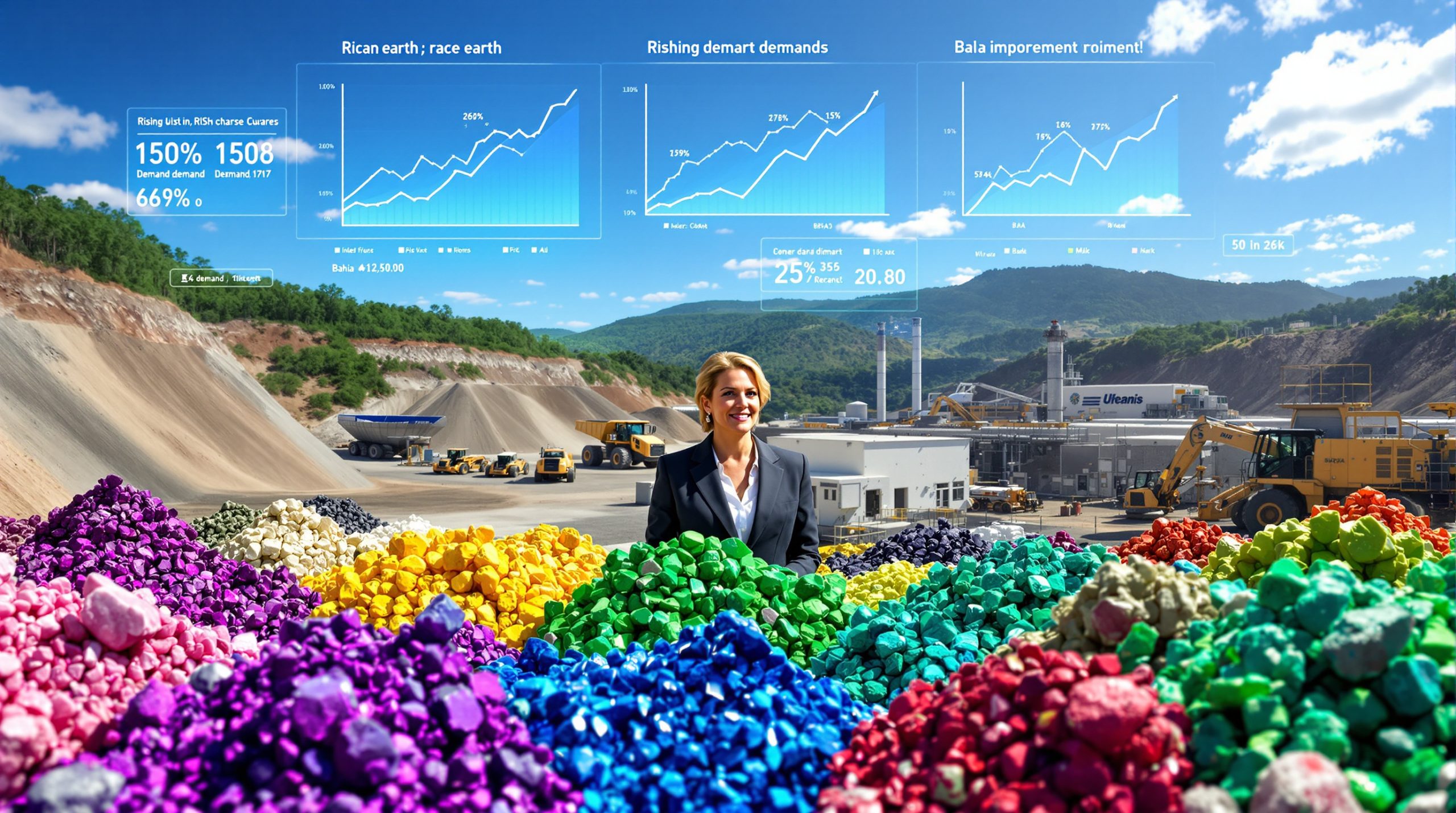Understanding China's Critical Minerals Smuggling Crackdown
In a landmark policy shift announced on July 19, 2025, Chinese authorities have implemented a sweeping "zero tolerance" stance against the smuggling of strategic minerals. This dramatic enforcement escalation was unveiled during a high-level meeting that brought together eight key government bodies, including the ministries of commerce, public security, state security, along with top court officials, prosecutors, and representatives from customs and postal agencies.
Key Elements of the Zero-Tolerance Policy
The new policy framework establishes four primary enforcement pillars:
- Complete prohibition of unauthorized mineral exports across all channels
- Enhanced law enforcement capabilities specifically targeting illegal shipments
- Stricter control mechanisms over technology transfers related to critical minerals
- Implementation of comprehensive monitoring systems at borders and shipping hubs
"Chinese authorities vowed 'zero tolerance' for smuggling of strategic minerals, pledging to strengthen law enforcement to crack down on illegal shipments and unauthorized transfer of related technology," according to the official announcement from the Ministry of Commerce.
This development signals China's most aggressive stance yet on protecting its mineral resources, with particular focus on rare earth elements and other strategically vital materials that form the backbone of modern technology manufacturing.
Why is China Cracking Down on Critical Minerals Smuggling Now?
The timing of China's enforcement escalation is no coincidence. Multiple factors have converged to create the perfect storm for this policy shift.
Geopolitical Considerations
China's move comes amid intensifying global competition for critical mineral resources. The country has systematically leveraged its dominance in rare earth production during the ongoing trade tensions with the United States, using export controls as a strategic tool in negotiations.
As one analyst noted, "This represents a clear message that China intends to maintain absolute control over its mineral advantage, particularly as Western nations scramble to develop alternative supply chains."
The policy also provides Beijing with enhanced strategic leverage in international negotiations, positioning the country to extract concessions in exchange for mineral access—particularly for elements essential to defense applications and energy transition minerals.
Economic and Security Factors
Beyond geopolitical chess moves, China's crackdown addresses several pressing domestic concerns:
- Resource preservation: Ensuring adequate domestic supplies for China's ambitious manufacturing goals through 2035
- Price stabilization: Preventing unauthorized exports that disrupt carefully managed market dynamics
- National security protection: Blocking foreign access to materials with dual-use applications
- Supply chain dominance: Maintaining China's position as the critical minerals gatekeeper
A particularly revealing aspect emerged when "China's spy officials accused overseas intelligence agencies of stealing controlled rare earth materials by mail," according to the Bloomberg report. Intelligence sources claim to have "foiled an attempt by an unnamed country to illicitly acquire rare earths for stockpiling," highlighting the national security dimensions of the crackdown.
How Does China's Export Control System Work?
China's mineral export control regime now ranks among the world's most comprehensive, with multiple verification layers and severe penalties for violations.
Current Regulatory Framework
At the core of the system lies a mandatory licensing protocol administered through the Ministry of Commerce. All shipments, regardless of volume or destination, require explicit approval through this centralized authority.
The system incorporates:
- Rigorous licensing requirements with extensive documentation
- Mandatory due diligence processes for all exporters
- End-user verification protocols to prevent unauthorized transfers
- Special restrictions on applications with potential defense implications
Exporters face increased compliance burdens as they are "given guidance on due diligence to prevent products reaching defense-related end users," according to official documentation. This places the onus on companies to thoroughly investigate their customers or face serious consequences.
Enforcement Mechanisms
The enforcement architecture supporting this system is equally robust:
- Blacklisting mechanism for non-compliant companies, effectively barring them from future export activities
- Prosecution of smuggling operations with enhanced penalties
- Interagency coordination for comprehensive border control
- Intelligence operations dedicated to identifying smuggling networks
While Chinese authorities claim to be "speeding up approvals" to maintain legitimate trade, industry reports suggest significant processing delays compared to pre-restriction periods, with some applications pending for months.
What Smuggling Methods is China Targeting?
Chinese authorities have identified several sophisticated smuggling techniques that circumvent traditional export controls, prompting more aggressive enforcement measures.
Common Smuggling Techniques
The most prevalent methods include:
- False customs declarations: Misrepresenting critical minerals as common industrial materials
- Transshipment through third countries: Routing exports through intermediary nations to disguise the final destination
- Unauthorized mail delivery: Using postal services to send small quantities that evade traditional customs screenings
- Composition misrepresentation: Altering or mislabeling mineral grades to evade control measures
These techniques have become increasingly sophisticated, with smugglers adapting quickly to enforcement measures. The new crackdown specifically targets these evolving methodologies with enhanced detection capabilities.
Recent Case Examples
Chinese authorities have cited several recent interceptions that illustrate the scale of the problem:
- Multiple shipments intercepted with falsely declared mineral contents, disguised as industrial waste or non-strategic materials
- Discovery of complex third-country transshipment operations designed to obscure the ultimate destination of controlled minerals
- Detection of unauthorized technology transfers related to rare earth processing
- Foiled attempt by foreign entities to acquire stockpiling materials through multiple fragmented purchases
"Recent cases of critical mineral smuggling involving false declarations and transshipments through third countries have raised alarm among Chinese authorities," stated the official announcement, highlighting the growing sophistication of evasion tactics.
How Does This Affect Global Critical Mineral Supply Chains?
The ripple effects of China's enforcement actions are already reverberating through global supply networks, creating both immediate disruptions and long-term structural changes.
Impact on International Markets
The immediate consequences include:
- Supply constraints for key industries dependent on Chinese materials
- Price volatility for affected minerals, with some seeing dramatic increases
- Increased documentation requirements adding friction to legitimate trade
- Pressure on alternative suppliers to fill gaps despite limited capacity
The licensing requirements have already resulted in governments "worldwide urging Beijing to boost flows," according to industry reports. Manufacturers of everything from electric vehicles to consumer electronics are reporting supply concerns as the verification process introduces new delays.
Industry Adaptation Strategies
Forward-thinking companies are implementing several strategies to navigate this new reality:
- Supply chain diversification toward non-Chinese sources where possible
- Increased investment in recycling technologies to recover critical minerals
- Strategic stockpiling of essential materials to buffer against disruptions
- Research into substitute materials with similar performance characteristics
These adaptations require significant investment and time, creating a challenging transition period for industries heavily dependent on Chinese supplies. Furthermore, the resource export challenges faced by alternative suppliers like Australia compound the difficulty of supply chain diversification.
What are Rare Earths and Why are They Important?
Understanding the significance of China's crackdown requires appreciating the unique properties and applications of rare earth elements.
Understanding Rare Earth Elements
Despite their name, rare earth elements are relatively abundant in the Earth's crust. What makes them "rare" is the difficulty of finding them in concentrations economically viable for extraction and processing.
The 17 rare earth elements include:
- Light rare earths: Lanthanum, Cerium, Praseodymium, Neodymium, Promethium, Samarium, Europium
- Heavy rare earths: Gadolinium, Terbium, Dysprosium, Holmium, Erbium, Thulium, Ytterbium, Lutetium, plus Scandium and Yttrium
Their unique properties—including exceptional magnetic strength, luminescence, and electrochemical characteristics—make them irreplaceable in numerous high-tech applications.
Note: The exceptionally strong magnets made from neodymium, praseodymium, and dysprosium are particularly critical for electric vehicle motors, wind turbines, and defense systems.
Global Dependency Concerns
China's dominance in the rare earth supply chain is unprecedented in modern industrial materials:
- Controls approximately 85% of global processing capacity
- Produces about 70% of the world's raw rare earths
- Maintains the most comprehensive expertise in separation and processing
- Holds significant patents on processing technologies
This concentration creates profound vulnerabilities for industries reliant on these materials, particularly as applications expand in renewable energy and electric transportation sectors.
How is China Managing its Rare Earth Export Quotas?
China has implemented a sophisticated quota management system that carefully balances domestic industrial needs with strategic export objectives.
Recent Quota Developments
In a notable development, China "quietly issued 2025 rare earth quotas without public announcement" in June 2025, according to industry reports. This departure from previous public declarations signals a shift toward less transparency in quota management.
While specific tonnage figures weren't publicly disclosed, industry analysts note several significant changes in the allocation methodology:
- Prioritization of domestic manufacturers with advanced processing capabilities
- Reduced allocations for companies with environmental compliance issues
- Increased scrutiny of end-user documentation for exported materials
- Preferential treatment for companies serving China's strategic industries
Historical Context of Export Controls
China's management of rare earth exports has evolved significantly over the past two decades:
- 2010-2015: Implemented strict quotas that triggered a WTO dispute
- 2015-2020: Shifted to production controls rather than export quotas following WTO ruling
- 2020-2025: Integrated export controls within broader national security framework
- 2025-present: Implemented the current "zero tolerance" enforcement regime
This evolution reflects China's growing sophistication in leveraging its resource advantage while navigating international trade obligations.
What are Other Countries Doing to Reduce Dependency?
Nations around the world are racing to develop alternatives to Chinese supply dominance, with varying degrees of success.
International Responses
Major economies have implemented multi-faceted approaches:
- Investment incentives for domestic mining and processing
- Strategic stockpiling of critical materials
- Research funding for recycling and substitution technologies
- Formation of international partnerships to secure diverse supply sources
The United States has been particularly aggressive, with the critical minerals order and mineral production order invoking the Defense Production Act to support domestic production and processing capabilities.
Emerging Production Centers
Several regions are positioning themselves as alternative suppliers:
- Australia: Rapidly expanding production through companies like Lynas Rare Earths
- United States: Reactivating mining operations at Mountain Pass and developing processing capabilities
- Canada: Advancing several rare earth mining projects with government support
- Europe: Focusing on urban mining (recycling) while developing relationships with non-Chinese suppliers
While promising, these alternatives face significant challenges in matching China's scale, cost advantages, and processing expertise in the near term.
What Role Do Intelligence Agencies Play in Mineral Security?
The involvement of intelligence services underscores the elevation of critical minerals from commercial concerns to matters of national security.
Allegations of Foreign Intelligence Operations
China's State Security Ministry has taken an unprecedented public stance on mineral security, directly accusing foreign intelligence agencies of targeting rare earth materials. According to official statements, Chinese counterintelligence has:
- Detected systematic attempts to circumvent export controls
- Identified mail-based smuggling operations with intelligence connections
- Disrupted a coordinated attempt by an unnamed nation to acquire materials for strategic stockpiling
- Uncovered industrial espionage targeting processing technologies
"China's spy officials accused overseas intelligence agencies of stealing controlled rare earth materials by mail," according to the Bloomberg report, marking a rare public acknowledgment of intelligence operations in this domain.
Security Measures for Critical Mineral Protection
In response to these perceived threats, China has implemented comprehensive security protocols:
- Enhanced physical security at production and processing facilities
- Cyber protection systems for technical data related to processing
- Personnel security clearances for workers in strategic mineral sectors
- Supply chain monitoring using advanced tracking technologies
- International intelligence cooperation with aligned nations
These measures reflect the growing securitization of mineral resources globally, with major powers increasingly viewing them through a national security lens rather than purely economic terms.
What Does This Mean for the Future of Critical Minerals Trade?
China's crackdown represents more than a temporary enforcement action—it signals a fundamental restructuring of global mineral supply relationships with far-reaching implications.
Long-term Implications
Several structural shifts are likely to emerge:
- Accelerated supply chain diversification away from Chinese dependence
- Premium pricing for verifiably legitimate and compliant materials
- Increased compliance costs affecting downstream product pricing
- Greater government involvement in mineral markets globally
- Emergence of new trading blocs based on mineral security partnerships
The era of treating critical minerals as ordinary commodities appears to be ending, replaced by a more strategic approach to these vital resources. Additionally, the geopolitical tensions impact from other global conflicts is further complicating the minerals landscape.
Potential Scenarios for Market Evolution
Looking forward, several scenarios could unfold:
- Diversification Succeeds: Non-Chinese suppliers successfully scale production, reducing China's market power
- Technology Breakthrough: Substitution or recycling innovations decrease dependence on primary supplies
- New Equilibrium: China maintains dominance but operates within a more regulated international framework
- Escalating Restrictions: Resource nationalism intensifies globally, fragmenting supply chains along geopolitical lines
The most likely outcome involves elements of all these scenarios, creating a more complex, higher-cost environment for industries dependent on critical minerals.
FAQ: China's Critical Minerals Export Controls
What specific minerals are covered under China's export controls?
China's export controls primarily focus on rare earth elements including neodymium, dysprosium, terbium, and other strategically important minerals essential for advanced manufacturing, renewable energy, and defense applications. The controls also extend to certain processing technologies and equipment used in refining these materials.
How quickly are export licenses being processed?
While the Chinese government has stated it is "speeding up approvals," specific processing timeframes remain unclear. Industry reports suggest significant delays compared to pre-restriction periods, with some applications remaining in processing limbo for 3-6 months, creating substantial uncertainty for global supply chains.
Can companies appeal if they're blacklisted for export violations?
The current regulatory framework includes limited appeal mechanisms, primarily through administrative review processes within the Ministry of Commerce, though success rates for appeals remain low. Companies facing blacklisting are advised to engage legal counsel with expertise in Chinese regulatory processes and consider diplomatic channels for resolution.
How are legitimate exporters supposed to conduct due diligence?
Exporters are required to implement comprehensive end-user verification systems, maintain detailed documentation of buyers, verify intended applications, and ensure materials won't be diverted to restricted uses or entities. This includes regular audits of customer operations, obtaining written end-use certifications, and implementing tracking protocols throughout the supply chain.
Disclaimer: This analysis represents the current understanding of China's critical minerals policies as of July 2025. Given the rapidly evolving nature of export controls and international mineral markets, readers should consult with legal and industry experts for the most current guidance on compliance requirements and market conditions.
Interested in Mining Investment Opportunities?
Discover how Discovery Alert’s proprietary Discovery IQ model provides rapid insights into significant mineral discoveries on the ASX, empowering traders and investors to make informed decisions. Explore major historical mineral finds by visiting the Discovery Alert Discoveries page and start your 30-day free trial for a competitive market edge.




